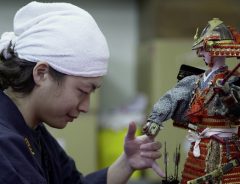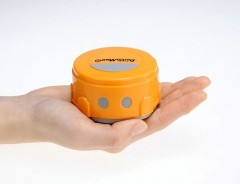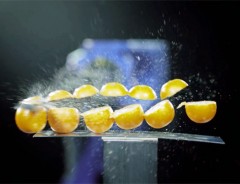- Tags:
- AI / companion robot / isolation / Robot / solitude
Related Article
-

Karakuri Puppets: The Foundation For Japan’s Advanced Robot Technology
-

This Palm-Sized Tiny Robot Cleaner “Swipes” Your Gadgets
-

Hate Folding Laundry? Just Leave It To The Laundroid
-

A Humanoid Buddy In Your Pocket: A Phone That Is Also A Walking Robot!
-

Modern-Day Samurai Vs. Cutting-Edge Robot In A Slicing Competition! How Do These Two Compare?
-

Japanese Farmers Deploy New Terrifying ‘Super Monster Wolf’ Robot Scarecrow



Humans are social creatures, but what happens when their social networks break down? Depression, cognitive decline, cortisol imbalances, and so on, and so on [1]. None of it beneficial. Companion robots may be able to provide emotional support increasingly missing from people's lives. While such a scenario sounds like a sci-fi pipe dream, 21st century Japan is developing the technology to make it a reality. For a good reason, too. There is a growing demand.
Solitude within the crowd
Japanese people are introverted. Here, there is a clear distinction between uchi and soto, one's in-group and out-group. Most people aren't likely to strike it up with members of the latter. Packed public transportation remains quiet, and sleeping passengers are left alone. Even well after the terminal stop. Often, only the station attendant bothers to rouse them.
While such a scene is relatively inconsequential, more significant social cohesion issues are easy to spot. Citizens in this society work long hours and are bound to company demands. Between official schedules and corporate social obligations, there is little time for family or friends. An endless number of isolating distractions like manga cafes and pachinko parlors only add to the problem. They are havens for customers who spend their free time alone.
Numbers confirm that residents of this densely crowded nation are paradoxically leading solitary lives. 18.4 million people, about 14% of the population, live alone. 1 in 5 will never marry as there isn't even the opportunity to date [2]. Naturally, fertility rates are falling, and there is a decreasing number of children. And grandchildren. If elderly residents have a family, they likely live far away, leading busy lives in metropolitan areas. Most tragically, however, every year, more people are literally dying alone in their homes [3].
Japan's companion robots
If the silence is deafening, perhaps a few beeps and bloops aren't so bad. Here are some of the more compelling products the Japanese companion robot industry has to offer.
Kirobo Mini
© PR Times, Inc.
The tiny and cute Kirobo Mini is Toyota's entry into the field. Meant as a companion inside the car and out, the automaton is capable of basic conversations. It also has a memory. Take it along on a hot-spring day trip, and the bot will reminisce the next time you go. Or, if it's interfaced with a car's GPS, the next time it's in the area. Like the retail-clerk inspired Pepper [link to Pepper article], the companion bot can gesticulate and react to human emotions. Maybe a solo road-trip doesn't sound lonesome after all [4].
Lovot
© PR Times, Inc.
We've featured Lovot before, but it's so cute that it's hard to ignore. Named best robot of the 2019 Consumer Electronics Show (CES), this droid's name is a portmanteau of "love" and "robot." It is a complex piece of machinery about the size of a cat. With 50 sensors and other goodies, owners can dress it, hug it, or coddle it like a baby.
Lovot's popularity speaks to the human need to be loved. When you think about it, the bot doesn't do much, only roll around and demand hugs. Yet, that intentional design choice is it's greatest, and perhaps only, selling point. Like a pet, it offers companionship, pure and simple. No cleanup necessary [5].
Erica
© SocialWire Co., Ltd.
Maybe you've seen her on the news. Not as the focus of a breaking story, but rather as an anchor reading headlines. Erica is an uncanny conversationalist who gives thoughtful and detailed responses. She can reminisce about her past and understand contextual information. While a fascinating spectacle, she comes off like the Manchurian Candidate. An impostor in human skin.
Creator Hiroshi Ishiguro, a professor at Osaka University, believes Erica has a soul. Who knows, maybe she does. After all, she has several hallmarks. The humanoid acts autonomously, leverages past memories, and becomes offended when accused of being creepy or obtuse. With further development, she may become a new source of stimulating company [6].
Robear
© RIKEN, Japan
You'll never guess, but Robear is a robot bear. Looking like a polar bear bound for orbit, it is anything but petite. The latest model weighs in at 140 kg. Earlier versions were as hefty as 230 kg.
Regardless, it needs the extra weight. Its primary purpose is providing elderly care by carrying infirm patients. Unlike the other robots featured, it lacks an AI charm. Rather it is intended to increase the independence of the elderly, which in turn improves mental health and outlook [7].
PARO
© PR Times, Inc.
While therapy comes in many forms, PARO may be the most adorable. It is a therapeutic baby seal robot. It is designed to have an emotional and calming effect. Like the cat cushion Qoobo, it responds to touch favorably by moving its tail and blinking its eyes. Ahhhhhh [8].
Its cute facade is somewhat deceptive, however. The bot contains tactile sensors and microphones. The bot’s internal processing allows it to seek eye contact, recognize faces, and learn actions like cuddling that generate positive responses. As a kind of adjuvant pet therapy, there are real therapeutic effects. PARO treatment reduces the symptoms of negative emotions, improves social engagement while supporting positive moods and quality of care [9].